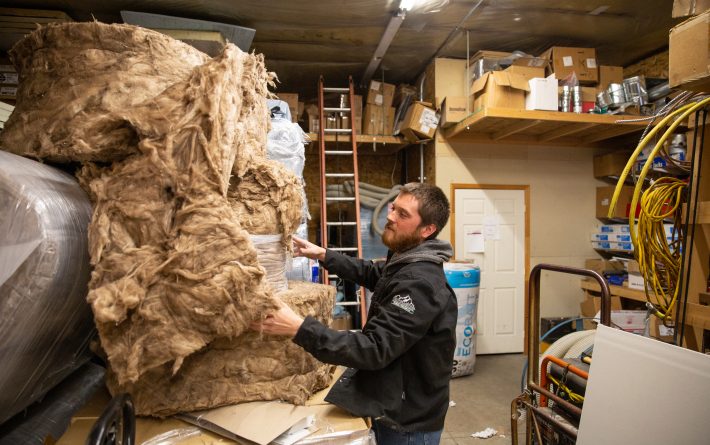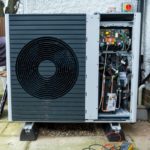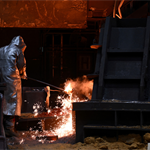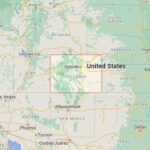Utility bills burn through paychecks for thousands of Coloradans – The Colorado Sun
Energy Disrupter
For the past five years, Susana Martinez Oliva has dreaded the onset of winter in Colorado.
She lives in a mobile home with her husband and six children in the Dotsero Mobile Home Park, alongside Interstate 70 near the eastern edge of Glenwood Canyon, a cold, windy corridor over 6,000 feet high in the mountains. Soon after the family moved into the mobile home, which they bought from a friend of Martinez’s husband, the furnace broke and they didn’t have the money to replace it. Instead, they rely on space heaters, placed strategically throughout the home.
A few years ago, the water heater stopped working, too. They bought a new one, but minerals from the hard tap water built up and it broke again last year. They couldn’t afford a new one.
Martinez had recently lost her job when the restaurant she worked at closed because of the COVID-19 pandemic—making her husband, a house painter, the sole breadwinner for the family of eight.
“Sometimes, I put pots of water on the stove to help warm up the house,” Martinez told me when I visited one day in early February. They pay $180 every month just for their electricity bill and about $80 for gas. “It’s been really expensive for us,” she said.
At the Dotsero Mobile Home Park, mobile homes run on propane for heat, which as of mid-February cost $2.92 per gallon. But about half of the homes in the park have broken furnaces, leaving families like Martinez’s reliant on electric space heaters and soaring energy bills. A few years ago, the park owner looked into switching to natural gas, but it was too expensive to install the lines out to the park, which sits on an isolated dirt road outside of Dotsero, a small, unincorporated community in the Eagle Valley.
Throughout Colorado, a quarter of families are like the Martinezes, facing disproportionate energy costs—a number that experts say is rising thanks to the economic crisis unleashed by the pandemic.
Energy Outreach Colorado is a nonprofit that partners with utility companies, the state and local governments to help Coloradans afford their energy needs. In 2020, 40% more people enlisted its services than in 2019, from replacing broken heating systems to improving home insulation, to providing subscriptions to renewable energy like solar gardens that help lower utility bills.
Outside Martinez’s mobile home, a team of workers had arrived from the Northwest Colorado Council of Governments (NWCCOG), an association of county and municipal governments that funds a variety of programs including weatherizing low-income homes. Two men were busy installing new roof insulation, part of a suite of home improvements designed to lower heating costs and reduce energy consumption.
In the back of a truck parked near the mobile home, a hopper fluffed up the new insulation to a rating of R-40, compared to the existing R-11 material, before shooting it through a long hose that extended onto the roof where a man on a ladder directed it inside the attic. The final step will be installing electric heat pumps, a heat pump water heater, and an induction range so Martinez and her family no longer rely on the expensive and carbon-emitting propane.
“It’s exciting,” Doug Jones, the energy director for NWCCOG, told me. “When we’re done, they’ll have an airtight, insulated home that’s efficient and safe—no more risks of gas leaks and carbon monoxide poisoning.”
Energy bills demand a greater share of income
Rural low-income households are among the Coloradans most at risk for energy insecurity. Families like the Martinezes spend a disproportionally high share of their income on energy bills, with a median energy burden almost three times greater than the burden faced by their higher-income counterparts, according to a 2018 report from the nonprofit American Council for an Energy-Efficient Economy (ACEEE): “As the cost of housing increases and the availability of affordable options decreases, rising energy costs further burden families who can least bear it, forcing low-income households to spend up to 20% of their income on energy services after the rent is paid.”
On Colorado’s Western Slope, the problem is exacerbated by the region’s severe housing crisis. “The more affordable homes aren’t necessarily the most energy efficient,” said Michelle Stewart, the executive director of the Yampa Valley Sustainability Council, noting that in Steamboat Springs, the average home selling price is $750,000—an unapproachable price for most families.
Nate Speerstra, the manager for NWCCOG’s energy program, echoed those findings. “We could spend the rest of our lives [weatherizing homes in] Garfield, Chaffee and Moffatt County,” he said—counties with high populations of low-income workers who commute to nearby ski resort communities like Aspen and Steamboat Springs.

The problems associated with high energy costs extend well beyond economic hardship. Andy Caler, the chief program officer for Energy Outreach Colorado, recalled how in Eagle, Colo., a local nonprofit arrived on one occasion to do an energy audit at a mobile home. The auditor found a gas leak under the house and carbon monoxide seeping through the furnace and water heater, which were located in the bedroom closet, next to where a mother and her son slept.
“There are hundreds of these scenarios,” Caler told me, “but that one kind of stuck with me.”
In other cases, people who require medical devices that run on their home electricity often face soaring utility bills they are unable to afford. “It’s life-threatening to not have that,” Caler said.
3-year wait list for help in the San Luis Valley
In Colorado, a patchwork of federal and state programs (known by an alphabet soup of acronyms like CARE and LEAP and WAP), as well as local nonprofits, fund energy audits, home energy efficiency improvements and utility bill assistance for people struggling with energy insecurity. But due to the various income and citizenship requirements, some people in need fall through the gaps, said Caler. In places like the San Luis Valley, which has a cold climate and high poverty rates, some federally funded programs like the U.S. Department of Energy’s Weatherization Assistance Program (WAP) have three-year waitlists.
In the Dotsero Mobile Home Park, five entities are funding the energy efficiency work: WAP, the Colorado Energy Office, Holy Cross Energy, Walking Mountains Science Center (a local nonprofit) and Eagle County. There are 1,500 mobile homes in the county and Eagle County has $50,000 for 20 of them in 2021.
Martinez heard about the weatherization program through the MIRA (Mobile Intercultural Resource Alliance) bus, which brings resources and services to Eagle County’s Spanish-speaking community. She filled out an application form and learned she was eligible for the energy efficiency upgrades, which Jones estimates will save almost $100 per month on Martinez’s energy bill. Often, the benefits go beyond simply the number of dollars saved; as the 2018 ACEEE report noted, research suggests that alleviating household energy burdens can help reduce respiratory illnesses like asthma triggered by mold, dampness and under-heating, as well as financial stress.
On the day I visited, the crew from NWCCOG was on their third day of work at Martinez’s mobile home, which Jones said would take roughly a week to complete. Already, they had repaired the house’s ducts so that the new furnace would deliver heat more efficiently. After the roof insulation was complete, they’d insulate around the base of the house so the floors stay warm; then they’d replace light bulbs and shower heads with energy-efficient models, and finally they’d cap the propane and install the electric heating and cooking components.
At the end, Jones told me, Martinez’s home would be effectively “wrapped in a down jacket.”

He pointed to a neighboring mobile home. “Just look at that flue, there,” he said, gesturing toward a small metal tube sticking out of the roof. It was lilting badly, which meant their water heater likely wasn’t venting properly, which can lead to poor indoor air quality. More than 50% of the manufactured homes NWCCOG has worked on have a health and safety problem. Improving energy efficiency can mean fewer health issues for things like asthma and carbon monoxide poisoning, the latter of which can cause flu-like symptoms and even be fatal.
Jones recalled how NWCCOG once worked on a house where a family was so crippled by their electric bills that they were keeping the thermostat at 63 degrees Fahrenheit. “They were cold all the time and still paying $140-$150 a month in utilities,” Jones said. Now, with their house at a livable temperature, their daughter is healthier and misses less school. “We kind of unlocked her potential for the future,” he said.
Frigid temperature, warm feeling
Inside the Martinez home, some kids were running around, while others were in the midst of virtual school classes while Martinez supervised them. Five years ago, the mobile home park was supposed to be their way out—an escape from the rising rents in Glenwood Springs and the other mountain towns in Colorado where Martinez’s husband paints homes, but where his own family could no longer afford to live. Instead, much of the money they saved went to pay their energy bills. Martinez said they would pile on sweaters to hang out in the living room and the kids were always getting sick.
A few days after the NWCCOG team had finished the first round of improvements, I called Martinez. The night before, the temperature had dropped to 10 degrees Fahrenheit, but the house felt warm and comfortable. “Everything is good,” she said.
Down the street, the crew from NWCCOG was already working on another home. Speerstra had told me that nationwide, weatherization programs help only 3% of qualified people.
“I try not to think about that,” he said, “but we’ve got job security for a long time.”
Freelance writer Sarah Tory wrote this story for The Colorado Trust, a philanthropic foundation that works on health equity issues statewide. It appeared at coloradotrust.org on March 9, 2021.
Original Source: https://coloradosun.com/2021/03/15/utility-bills-burn-through-paychecks-for-thousands-of-coloradans/


















